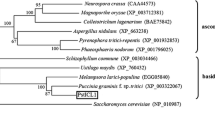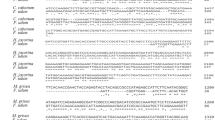Abstract
The sucrose non-fermenting protein kinase 1 gene (SNF1) regulates the derepression of glucose-repressible genes in microorganisms. In this study, we cloned an ortholog of SNF1 from Penicillium digitatum and characterized its functions through a gene knock-out strategy. Growth of the PdSNF1 mutant (ΔPdSNF1) on the synthetic medium (SM) supplemented with pectin or polygalacturonic acid was severely disturbed. The appearance of disease symptoms on the ΔPdSNF1 mutant-inoculated citrus fruits was significantly delayed as well. The expression levels of the cell wall-degrading enzyme (CWDE) genes (e.g., XY1, PL1, PNL1, and EXPG2) after pectin induction were up-regulated in wild type, but unchanged or less up-regulated in the ΔPdSNF1 mutant. During infection in citrus fruit, the up-regulation of XY1 was delayed in the ΔPdSNF1 mutant. Disruption of PdSNF1 also resulted in impaired conidiation and caused malformation of the conidiophore structures. In addition, the expression of BrlA, a gene that regulates conidiophore development, was significantly impaired in the ΔPdSNF1 mutant. However, the expression of FadA, encoding the α-subunit of a heterotrimeric G protein, was up-regulated in this mutant. Collectively, our results demonstrate that the PdSNF1 plays a role in adapting P. digitatum to alternative carbon sources. Its involvements in the virulence of P. digitatum is probably via regulation of the expression of CWDE genes; and it is also involved in conidiation, probably through activation of the conidiation signaling pathway while inactivating the mycelial growth-signaling pathway.








Similar content being viewed by others
References
Adams TH, Boylan MT, Timberlake WE (1988) brlA is necessary and sufficient to direct conidiophore development in Aspergillus nidulans. Cell 54(3):353–362
Aro N, Pakula T, Penttilä M (2005) Transcriptional regulation of plant cell wall degradation by filamentous fungi. FEMS Microbiol Rev 29(4):719–739
Ashrafi K, Lin SS, Manchester JK, Gordon JI (2000) Sip2p and its partner Snf1p kinase affect aging in S. cerevisiae. Genes Dev 14(15):1872–1885
Barmore C, Brown GE (1979) Role of pectolytic enzymes and galacturonic acid in citrus fruit decay caused by Penicillium digitatum. Phytopathol 69:675–678
Boylan MT, Mirabito PM, Willett CE, Zimmerman CR, Timberlake WE (1987) Isolation and physical characterization of three essential conidiation genes from Aspergillus nidulans. Mol Cell Biol 7(9):3113–3118
Carlson M, Osmond BC, Botstein D (1981) Mutants of yeast defective in sucrose utilization. Genetics 98(1):25–40
Celenza JL, Carlson M (1984) Cloning and genetic mapping of SNF1, a gene required for expression of glucose-repressible genes in Saccharomyces cerevisiae. Mol Cell Biol 4(1):49–53
Crute BE, Seefeld K, Gamble J, Kemp BE, Witters LA (1998) Functional domains of the α1 catalytic subunit of the AMP-activated protein kinase. J Biol Chem 273(52):35347–35354
Cullen PJ, Sprague GF Jr (2000) Glucose depletion causes haploid invasive growth in yeast. Proc Natl Acad Sci USA 97(25):13619–13624
DiPietro A, Roncero MIG (1996) Endopolygalacturonase from Fusarium oxysporum f. sp. lycopersici: purification, characterization, and production during infection of tomato plants. Phytopathol 86(12):1324–1330
Hardie DG (2007) AMP-activated/SNF1 protein kinases: conserved guardians of cellular energy. Nat Rev Mol Cell Bio 8(10):774–785
Hardie DG, Carling D, Carlson M (1998) The AMP-activated/SNF1 protein kinase subfamily: metabolic sensors of the eukaryotic cell? Annu Rev Biochem 67:821–855
Honigberg SM, Lee RH (1998) Snf1 kinase connects nutritional pathways controlling meiosis in Saccharomyces cerevisiae. Mol Cell Biol 18(8):4548–4555
Hooykaas P, Roobol C, Schilperoort R (1979) Regulation of the transfer of Ti plasmids of Agrobacterium tumefaciens. J Gen Microbiol 110(1):99–109
Jiang J, Liu X, Yin Y, Ma Z (2011) Involvement of a velvet protein FgVeA in the regulation of asexual development, lipid and secondary metabolisms and virulence in Fusarium graminearum. PLoS One 6(11):e28291
Jiang R, Carlson M (1997) The Snf1 protein kinase and its activating subunit, Snf4, interact with distinct domains of the Sip1/Sip2/Gal83 component in the kinase complex. Mol Cell Biol 17(4):2099–2106
Kanetis L, Forster H, Adaskaveg JE (2007) Comparative efficacy of the new postharvest fungicides azoxystrobin, fludioxonil, and pyrimethanil for managing citrus green mold. Plant Dis 91(11):1502–1511
Kuchin S, Vyas VK, Carlson M (2002) Snf1 protein kinase and the repressors Nrg1 and Nrg2 regulate FLO11, haploid invasive growth, and diploid pseudohyphal differentiation. Mol Cell Biol 22(12):3994–4000
Lee SH, Lee J, Lee S, Park EH, Kim KW, Kim MD, Yun SH, Lee YW (2009) GzSNF1 is required for normal sexual and asexual development in the ascomycete Gibberella zeae. Eukaryot Cell 8(1):116–127
Li M, Gong X, Zheng J, Jiang D, Fu Y, Hou M (2006) Transformation of Coniothyrium minitans, a parasite of Sclerotinia sclerotiorum, with Agrobacterium tumefaciens. FEMS Microbiol Lett 243(2):323–329
Macarisin D, Cohen L, Eick A, Rafael G, Belausov E, Wisniewski M, Droby S (2007) Penicillium digitatum suppresses production of hydrogen peroxide in host tissue during infection of citrus fruit. Phytopathol 97(11):1491–1500
Mahmood A, Greenman J, Scragg A (1998) Orange and potato peel extracts: analysis and use as Bacillus substrates for the production of extracellular enzymes in continuous culture. Enz Microb Tech 22(2):130–137
Ospina-Giraldo MD, Mullins E, Kang S (2003) Loss of function of the Fusarium oxysporum SNF1 gene reduces virulence on cabbage and Arabidopsis. Curr Genet 44(1):49–57
Ostling J, Ronne H (1998) Negative control of the Mig1p repressor by Snf1p-dependent phosphorylation in the absence of glucose. Eur J Biochem 252(1):162–168
Pfaffl MW, Horgan GW, Dempfle L (2002) Relative expression software tool (REST©) for group-wise comparison and statistical analysis of relative expression results in real-time PCR. Nucleic Acids Res 30(9):e36
Polge C, Thomas M (2007) SNF1/AMPK/SnRK1 kinases, global regulators at the heart of energy control? Trends Plant Sci 12(1):20–28
Prusky D, McEvoy JL, Saftner R, Conway WS, Jones R (2004) Relationship between host acidification and virulence of Penicillium spp. on apple and citrus fruit. Phytopathol 94(1):44–51
Qin G, Tian S, Chan Z, Li B (2007) Crucial role of antioxidant proteins and hydrolytic enzymes in pathogenicity of Penicillium expansum. Mol Cell Proteomics 6(3):425–438
Ronne H (1995) Glucose repression in fungi. Trends Genet 11(1):12–17
Santangelo GM (2006) Glucose signaling in Saccharomyces cerevisiae. Microbiol Mol Biol Rev 70(1):253–282
Sun X, Wang J, Feng D, Ma Z, Li H (2011) PdCYP51B, a new putative sterol 14α-demethylase gene of Penicillium digitatum involved in resistance to imazalil and other fungicides inhibiting ergosterol synthesis. Appl Microbiol Biotechnol 91:1107–1119
Tamura K, Dudley J, Nei M, Kumar S (2007) MEGA4: molecular evolutionary genetics analysis (MEGA) software version 4.0. Mol Biol Evol 24(8):1596–1599
Tang QY, Feng MG (2007) DPS data processing system: experimental design, statistical analysis and data mining. Science Press, Beijing, China
Tonukari NJ, Scott-Craig JS, Walton JD (2000) The Cochliobolus carbonum SNF1 gene is required for cell wall-degrading enzyme expression and virulence on maize. Plant Cell 12(2):237–247
Treitel MA, Kuchin S, Carlson M (1998) Snf1 protein kinase regulates phosphorylation of the Mig1 repressor in Saccharomyces cerevisiae. Mol Cell Biol 18(11):6273–6280
Twumasi-Boateng K, Yu Y, Chen D, Gravelat FN, Nierman WC, Sheppard DC (2009) Transcriptional profiling identifies a role for BrlA in the response to nitrogen depletion and for StuA in the regulation of secondary metabolite clusters in Aspergillus fumigatus. Eukaryot Cell 8(1):104–115
Tzima AK, Paplomatas EJ, Rauyaree P, Ospina-Giraldo MD, Kang S (2011) VdSNF1, the sucrose nonfermenting protein kinase gene of Verticillium dahliae, is required for virulence and expression of genes involved in cell-wall degradation. Mol Plant Microbe Interact 24(1):129–142
Walton JD (1994) Deconstructing the cell-wall. Plant Physiol 104(4):1113–1118
Wang J, Li H (2008) Agrobacterium tumefaciens-mediated genetic transformation of the phytopathogenic fungus Penicillium digitatum. J Zhejiang Univ-Sc B 9(10):823–828
Yi M, Park JH, Ahn JH, Lee YH (2008) MoSNF1 regulates sporulation and pathogenicity in the rice blast fungus Magnaporthe oryzae. Fungal Genet Biol 45(8):1172–1181
Yu JH, Wieser J, Adams T (1996) The Aspergillus FlbA RGS domain protein antagonizes G protein signaling to block proliferation and allow development. Embo J 15(19):5184–5190
Zhang Z, Wu K, Li H (2008) Sensitivity of Penicillium digitatum in Zhejiang to the strobilurin fungicide azoxystrobin. Chin J Pestci Sci 10(3):375–378
Zhu J, Xie Q, Li H (2006) Occurrence of imazalil-resistant biotype of Penicillium digitatum in China and the resistant molecular mechanism. J Zhejiang Univ-Sc A 7:362–365
Zuber S, Hynes MJ, Andrianopoulos A (2002) G-protein signaling mediates asexual development at 25 °C but has no effect on yeast-like growth at 37 °C in the dimorphic fungus Penicillium marneffei. Eukaryot Cell 1(3):440–447
Acknowledgment
This work was supported by the National Foundation of Natural Science of China (31071649), China Agriculture Research System (CARS-27) and the Special Fund for Agro-Scientific Research in the Public Interest (201203034).
Author information
Authors and Affiliations
Corresponding author
Rights and permissions
About this article
Cite this article
Zhang, T., Sun, X., Xu, Q. et al. PdSNF1, a sucrose non-fermenting protein kinase gene, is required for Penicillium digitatum conidiation and virulence. Appl Microbiol Biotechnol 97, 5433–5445 (2013). https://doi.org/10.1007/s00253-012-4593-z
Received:
Revised:
Accepted:
Published:
Issue Date:
DOI: https://doi.org/10.1007/s00253-012-4593-z




